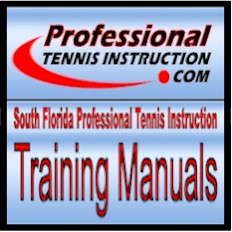|
Form and Balance
By: Andrew S. Rosz
South Florida Professional
Tennis Instruction
Hollywood, Florida , USA
(954) 922-8040
THE TWO-STEP STROKE
Step 1. A normal and usually correct backswing. Here, TM1 has achieved a motionless
position, properly positioned at the appropriate o'clock position, and has reached its
MAXIMUM BACKSWING POSITION. The racket head is back and waiting to prepare for its
"ONLY-FORWARD" motion.
Step 2. The racket begins its only-forward motion completely independent of the
backswing motion. This second step is the hit and follow-through combined.
Note: As more fully described in the section on "General
Techniques," TM1 refers to "from the waist up" and TM2 refers to "from
the waist down."
SUMMARY OF TM2 TECHNIQUES
- TM2 must be fully sideways before you begin the forward motion; TM1 faces four o'clock
on forehands and eight o'clock on backhands
- TM2 attains a brief position of motionless when the backswing is fully extended
- Recognize this position of motionless as the backswing/forward swing transitional period
- During this transitional period, body weight is equally distributed among both feet
- As the forward motion begins, TM2 shifts the body weight to the leg opposite the hitting
arm and pivots back to the ready position
SUMMARY OF TM1 TECHNIQUES
The Hit:
- The hit is an only-forward motion (two-step stroke)
- ACCELERATE SMOOTHLY when beginning the forward motion
- Maintain a firm wrist (grip) at impact
- At impact, the racket is a linear extension of the forearm
- Be aware of racket pitch at impact
The Follow-Through:
- Aids the body in returning both TM1 and TM2 back to the ready position
- Provides right/left directional ball control in conjunction with timing
- Use a complete follow-through
- Follow-through with the racket head HIGH on each and every shot
- Use a three-second follow-through for neutral groundstrokes
- Maintain a firm wrist during the entire follow-through
- Use the non-hitting arm to catch the follow-through and check the grip
- Check the grip as the racket is lowered back to the ready position
To recap the activities of TM1 and TM2 while executing a stroke...
From the ready position, TM2 goes to work to properly position both the body's o'clock
position and the actual physical court location (80% of the backswing motion). TM2 now
brings the body to a motionless, balanced position. In this position, the racket head is
back and waiting for the ball. Thus far, TM1 has done practically no work at all. Now, the
emphasis transfers to TM1 to execute the proper only-forward motions of the hit and
follow-through. Once the follow-through has completed all forward motions, TM1 and TM2
work together to return to the ready position and await the next shot. The stroke emphasis
can now be summarized as follows... TM2 (backswing)... then TM1 (forward swing)... then
both TM2 and TM1 together (recovery back to the ready position).

|
Note: Each of the tennis
tips outlined above are more fully discussed in a series of
expertly-written tennis instruction training manuals and book publications
for players who prefer to be "self-taught." For more
information on our world-renowned SFPTI tennis instruction
training manuals and book publications CLICK
HERE. |
Back
|